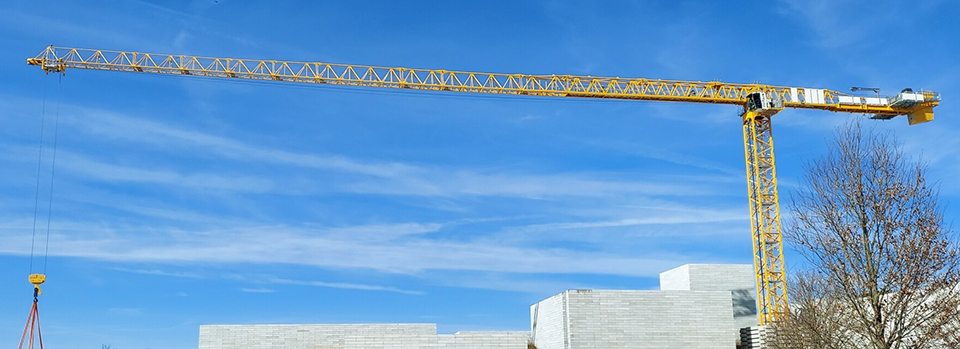Thank you for your interest in Potain self-erecting tower cranes.
Please fill out the form below and a crane expert will contact in 1-3 business days.
We use cookies on our website to give you the most relevant experience by remembering your preferences and repeat visits. By clicking “Accept”, you consent to the use of ALL the cookies. To learn more view our cookie policy.
Lenkin Enterprises Chooses Potain MDT 809 Cranes for Major Projects in the DC Area
- One MDT 809 with a custom 279-foot (85 m) jib can reach most of the perimeter of an art museum renovation project in Maryland.
- A second unit is delivering the required jib-end lifting power for an office building overhaul at Georgetown University.
- The MDT 809 is Potain’s largest topless tower crane for the U.S. market.
Washington, D.C.-based contractor Lenkin Enterprises has selected two Potain MDT 809 tower cranes for important construction projects in Potomac, Maryland, and Washington, D.C. The Potain cranes are essential for two challenging developments: the renovation of a modern and contemporary art museum in Maryland and the repurposing of an office building at Georgetown University.
Lenkin Enterprises is headed by structural engineer Michael Lenkin, whose career in construction spans nearly 40 years. Faced with the challenges of meeting specific lifting requirements for the two projects, Lenkin worked with Manitowoc Lift Solutions to develop customized solutions.
For the museum project, a crane with a long jib and extended reach was required to minimize disturbance to the museum's landscape, which includes over a hundred acres of native meadows. To reduce environmental impact, the project called for the use of a single tower crane instead of two. This meant using one crane to reach most of the building's perimeter to make the work feasible.
“The Potain team and the Manitowoc Lift Solutions division worked hand in hand with me to find the right solution so we could adapt the MDT 809 to meet my needs,” Lenkin said. “I was able to get an 85-m jib for the crane with the capacity my client wanted on a static base, despite having to shoehorn this crane into an alcove at the museum. There were a lot of different challenges, but the work of the team at Manitowoc both in France and the U.S. made it possible.”

The MDT 809 at the museum project is notable for being the first in North America to use the ZY854 cross-shaped base, which supports high working heights without adversely impacting set-up or operation costs. It’s also the first MDT 809 crane with a 279 ft (85 m) jib and the first to support both the 2-part/4-part trolley (SM/DM) and full-time 2-part trolley (SM Pur). The cross base is supported on pile caps and micropiles to transfer the loads below the museum. The crane and foundations were coordinated carefully with existing buried utilities.
“This crane and its long reach are crucial for the renovation of the art museum,” Lenkin added.
At Georgetown University, the Potain MDT 809 is the central figure in repurposing a 40-plus-year-old office building. The crane’s strong capacity is crucial in removing and resetting granite-clad precast panels, with estimated weights of approximately 24,000 lbs. The MDT 809 is also setting structural steel and performing demolition tasks. The project involves significant structural work, and the MDT 809 at the site has a 60 m hook reach with an SM/DM trolley, and 12.8 USt (11.6 t) tip capacity as required by the project.

The crane is supported on a ZY854 ballasted cross base on top of the existing building structure. The base cross is supported by existing and temporary structural steel columns down to the building’s foundation system.
Lenkin expressed satisfaction with Potain’s performance and support throughout both projects.
“The collaboration with the Potain team has been seamless,” he said. “From local and international engineering support to rapid response times, Potain has consistently delivered on our project-specific needs.”
For over 30 years, Lenkin has worked with and invested in tower cranes, gaining deep expertise and a keen understanding of their capabilities. His first introduction to Potain cranes dates back to 1994, and his direct interactions with Potain began in the early 2000s.
While the company has long-running experience working with Potain cranes, the two MDT 809 units are the first the company has owned. The model is the largest Potain topless crane available in the U.S.
